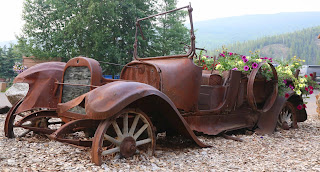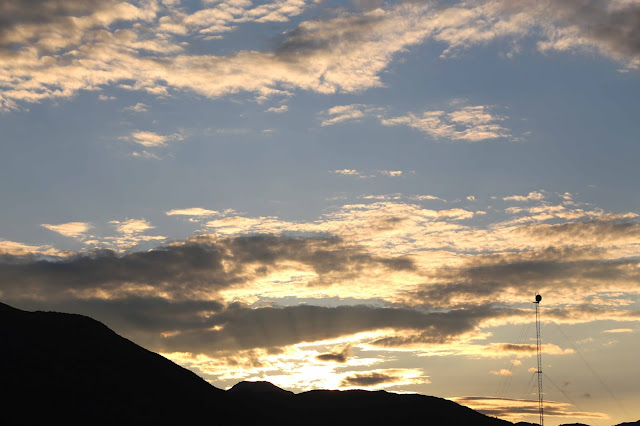One
of the goals of this trip was to be inside the Arctic circle, on June
21st to see the sun NOT set.
That
would involve a 275 mile (each direction) trip down the famed and
treacherous Dalton Highway to Coldfoot Alaska. We didn't want to go
all the way up to Prudoe Bay. The Dalton is similar to some of the
horrible roads we've seen before, but with the added 'feature' of
many large long-haul trucks. They barrel down the road, and have the
right of way – it is their road. It's also, hard to imagine, even
more remote than where we had been so far ... but it is.
We
decided that rather than drive Miss Daisy (the RV) , we'd take the
'Dalton Express' public transportation to and from Coldfoot, and stay
in the lodge there. The 'Dalton Express' service uses the vehicle
size appropriate for the number of booked passengers. We were the
only passengers in an E450 van outfitted with beefed up tires, along with the driver, his 9 year old daughter. and 3 oil drums and other supplies that we dropped off at camps along the way. Our driver had driven the route about 60 times, and loves it. It was a
very rough ride and Daisy was thankful to have been left behind. She got a good rest, and it turned out to be a good decision for another reason - gas was $4.99 a gallon in Coldfoot.
Daisy
stayed at a campground in Fairbanks and the young campground host fed
Stinky while we were gone.
Dalton
Highway
The
Dalton is considered one of Alaska's most remote and dangerous
highways that opened to the public in 1995. It is nicknamed the 'Ice
Road' or 'Haul Road' (as featured on a TV series). It was built as
the primary access road for transport of goods, materials, and
construction crews for the building of the Alaskan pipeline. There
are very few and only the most basic services – no cell service, no
roadside service etc.
Communication by CB radio is essential – the
drivers all talk to each other along the way, reporting their
location, giving permission to pass, and driver alerts. We saw
massive structures (wider than the road) being transported. In those
cases, there is a pilot car that re-routes all oncoming traffic into
large pull-outs.
The road is built 6-15 feet above the permafrost
with small or no shoulders and, of course, no guardrails. There are
10-12% grades in some areas. Rollovers are not uncommon. The 415
mile long road took 5 months to build in 1974. It goes on, and on, and on ... relentlessly. Notes regarding pictures - please forgive some of the photograph quality as they were taken from the back seat of a truck going down the road over teeth shattering frost heaves, potholes and rocky surfaces.
The highway was built for the
pipeline construction, although not beautiful in itself, is an
engineering marvel.
We saw a distant wildfire. There are many in Alaska this summer.
We saw several motorcycle groups (mostly
international guests) on organized tours.
Along
the highway, we stopped at a way station that was started by a family
many years ago. They raised 6 biological and 18 adopted children, home schooling them all, in
the compound that they built themselves. It's a very interesting
outpost. Free coffee!!!
We saw miles and miles of little white flowers. They turn out to be high protein food for caribou and moose who migrate through here fattening up their new calves before the hard winter.
We saw miles and miles of Black Spruce - a native tree that grows well with shallow roots (as the roots cannot penetrate the permafrost). They grow in this harsh environment and look pretty ratty in their natural state. They don't grow very big. A tree with a 2 inch diameter is about 150 years old.
We crossed the Arctic Circle.
As we approached Coldfoot, there were mountains.
Coldfoot
Camp
MOSQUITOES.
The most we've seen anywhere. Since this area is all permafrost
(permanently frozen ground right under the surface), there is no
place for rain to be absorbed – so it sits on top of the land in
puddles and creeks that go nowhere – prime mosquito producing
territory. And so little time for all the multiplication that needs to happen to sustain the population !!!
Coldfoot airport:
Sign just outside Coldfoot for those wishing to drive to Prudhoe Bay. There is NOTHING between Coldfoot and Prodhoe
We
over-nighted in very basic accommodations (the white building). It might be considered a
two star motel because we did have private indoor plumbing in our
room, and it appears that the only bugs were mosquitoes on the other
side of the screen.

Coldfoot
now is a big truck stop – the last gas and services before Prudoe
Bay, 240 miles to the north. It was built on the site of an old
mining camp. It was named Coldfoot because many of the green gold
seeking stamppeeders tasted the northern climate, didn't like it, got
cold feet, and departed. Coldfoot Camp was re-established in the
1970's to house pipeline workers and later as a major truck stop. There is a pay phone on site.
Kris's shadow at 10:30p.m.
Coldfoot
has the furthest north watering hole in the United States (the Frozen
Foot Saloon) – we made a point to sample their beer.
The post
office is open 3 days a week.
Sign inside the post office entrance:
Wiseman
We
had a 30 minute hour tour of Wiseman (at 9:00 at night – still in
full light). It's a short, beautiful drive north of Coldfoot.


The
town was established in 1908 as a mining camp and currently houses 13
anglo (non-native) permanent residents who lead a subsistence
lifestyle. The town is in a county that has 3500 students, and two
teachers. Most of the students are home schooled. There are some original residences in the area we toured.




A
local resident spoke with our group for about 20 minutes on how they
live in such rugged conditions. He hunts, traps, fishes, berry picks
and grows vegetables. He is married and has a two year old daughter.
He hates his windmill (the mechanics don't hold up) and loves his
solar. They store 600 pounds of potatoes, other roots and tubers,
and berries in a trap door from his kitchen down to a 'permafrost'
cellar that acts as a refrigerator. They eat off that all winter.
He reminded us that June 21st is the MIDDLE of his summer
– not much growing time left for the vegetable garden. The growing
season is 60-90 days long. When he hunts, he must carry out his kill
my non-mechanical means (one of the requirements of the sustainable
lifestyle permits). He field dresses the animal and carries as much
as he can, then goes back for more. Sometimes there are other
animals 'working on' his catch when he returns for the balance and he
has to relinquish the rest to them.
Sunset
(NOT)
We
stayed up until 12:00 to watch the sky, then set the alarm for 2:00,
and 4:00 to watch it again.
Midnight:
2:00 - After midnight, the sun tucked behind the mountains, and did not drop below the flat horizon, which we could not see, because of the mountains.
4:00 - the second picture is the across the valley 'alpenglow' on distant mountains from the not set sun
The next day was a pretty tired one
since we could not sleep going back – again, the frequent teeth
shattering bumps and potholes.
We left early morning to return to Fairbanks.She was on the driveway of Coldfoot camp as we were leaving.
The views returning gave up a tremendous appreciation for how many rows of mountains needed to be traversed to get back to Fairbanks.



Animals
we saw: porcupine, great horned owl, rabbits, unknown bird that plucked food
off our dinner plate, and a 1 year moose. Flowers ... many, including fireweed:
It was a wonderful and exhausting two days. Stinky did fine without us ... we're not sure he even knew we were gone !Happy trails until next post ...



















































































